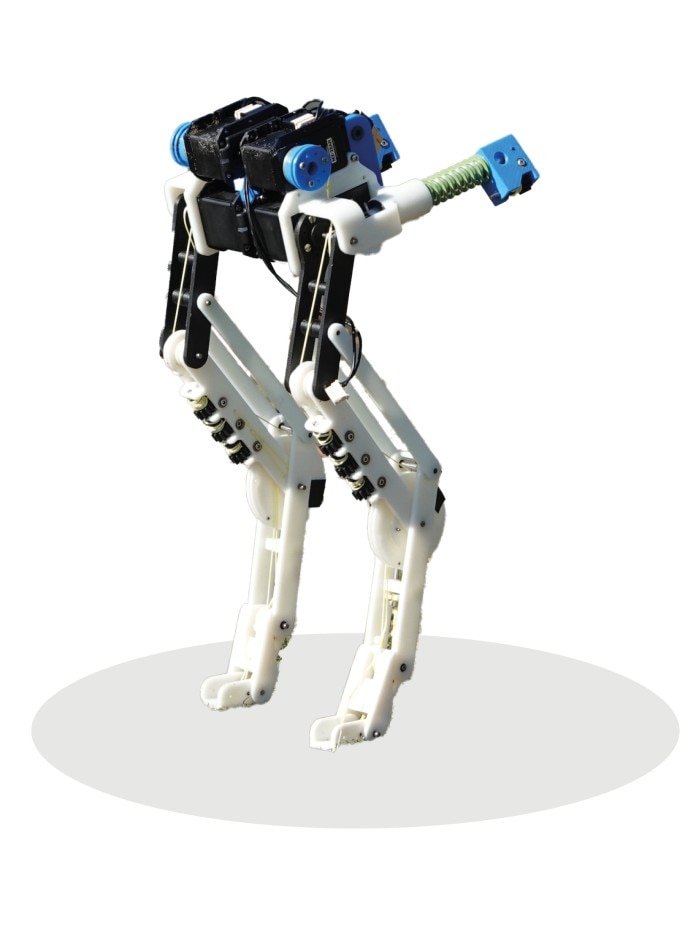-
- Benchtop Centrifuges
- Floor-Standing Centrifuges
- Refrigerated Centrifuges
- Microcentrifuges
- Multipurpose Centrifuges
- High-Speed Centrifuges
- Ultracentrifuges
- Concentrator
- High-Speed and Ultracentrifugation Consumables
- Accessories
- Tubes
- Plates
- Device Management Software
- Sample and Information Management
- IVD Products

Making Big Leaps
Beyond Science
- Research
- Off the Bench
- Off the Bench
- Inspiring Science
Softer materials and more intense interactions with humans: the scope of capabilities of robots continues to grow. Research is strongly guided by the examples of animals and plants. Bionics as a model of perfection.
Quick as a bird
This principle of evolutionary success is what the researchers at the MPI-IS have now applied to a robotic running mechanism. And indeed, the BirdBot has excelled during test runs through its particularly high efficiency – just like the locomotion apparatus of live birds, explains Alexander Badri-Spröwitz, head of the research group Dynamic Locomotion at the MPI-IS. “Previously, our robots were forced to work against the spring or engage a motor while either standing or lifting a leg to ensure that the leg would not collide with the ground during the swinging phase.” This is no longer the case with BirdBot. “Altogether, it requires only a quarter of the energy compared with previous walking robots”, adds co-developer Alborz Aghamaleki Sarvestani. According to the scientists, their robot leg is amenable to scaling – even large robots can be made to run while maintaining a low energy expenditure.
Bionics is the term for this principle, which borrows strategies from animals or plants and transfers it to technology. It starts with robot grippers which simulate the arms of an octopus, to maintenance robots which swim through pipe systems by utilizing the fin movements of the ocean planarian, all the way to specialized coatings that resemble shark skin to improve the aerodynamics of airplanes. Starting this year, Lufthansa Cargo is planning to equip its entire fleet with this technology in order to save approximately 3,700 tons of jet fuel and almost 13,000 tons of CO₂ annually.
Visually, the giants of the air will bear no resemblance to the emperor of the oceans.Importantly, bionics attempts to not simply imitate its model, but instead, based on nature’s strategies, it provides innovative solutions to technological questions and demands.
Read more
Read less
Interdisciplinary at all times
Experts from the fields of biology, physics, materials science and engineering collaborate across disciplines. Many researchers are particularly intrigued by energy efficiency and lightweight construction, as well as by nature’s combination of power and flexibility: these are the qualities which typically elude heavyweight industrial robots made of steel. The very young field of softbots – flexible robots made from soft materials – would not have been imaginable without its blueprints from nature. In this fashion, the German manufacturer Festo develops robots and grippers which are capable of interacting safely with their human colleagues.
Thanks to their flexibility, soft robots are also a good choice when it comes to extreme situations: Chinese researchers enabled a robot inspired by the snailfish to dive to the deepest point in our oceans – the Mariana Trench. This is where the small robot made from silicone, and its delicate electronics, withstood the pressure of a water column 11 kilometers high.

A team from the University of Colorado Boulder and the MPI-IS in Stuttgart have instead taken a leaf out of the spider’s book. Their arachnobot can leap across distances ten times its body height. The centerpiece: the joints are inspired by spiders which, through utilization of hydraulic forces, function similarly to the stretching of a leg by the creature. According to the researchers, these joints are highly functional; they are simple and cheap to produce, and they consume very little electricity. “It was not the ultimate goal of our research to construct a spider robot” says Philipp Rothemund of the MPI-IS. “Rather, we set out to develop a state-of-the-art, active joint that can be incorporated into any type of robot.”
Until this can be achieved, however, researchers will have to continue to overcome a number of hurdles as their softbots are not readily compatible with conventional and standardized robot systems, explains Christoph Keplinger, director at the MPI-IS: “We must therefore develop novel, effective and robust interfaces for the functional soft materials in order to integrate individual components into powerful robot systems.”
Not all bionic concepts make it all the way to practical application. And it is not necessarily the goal. Many consider these concepts to be applied basic research, with the intention of furthering biology and technology alike. After all, bionics mimic their models based in nature: sometimes, it just takes a longer time and additional development to reach perfection.
Read more
Read less
